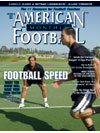AMERICAN FOOTBALL MONTHLY THE #1 RESOURCE FOR FOOTBALL COACHES
Article CategoriesAFM Magazine
|
Bandit 2 ReadCover 2 Read alignment and techniquesby: Scott Orloff Defensive Coordinator/Secondary Coach, Orange Coast College © More from this issue Our base defensive alignment is a 4-3 gap control defense while we play a 2 read coverage behind it. I first learned the 2 read coverage from Sonny Lubick when he was the defensive coordinator at the University of Miami. I feel I have really refined Sonny’s scheme over the past 14 years. By using 2 read as our base coverage, it not only allows us to execute multiple coverages and disguises in the secondary, but most importantly, this coverage gives us the opportunity to run a coverage predicated to pattern combinations instead of calling just a single coverage. We will run a lot of duel coverages on one defensive call. For example, we might run 2 read on the strong side of our opponent’s offensive passing formation and run zero coverage to the weak side. I will focus on the key coaching points on our 2 read coverage as well....The full article can only be seen by subscribers. Subscribe today!
|
|
|||||||
| HOME |
MAGAZINE |
SUBSCRIBE | ONLINE COLUMNISTS | COACHING VIDEOS |
Copyright 2025, AmericanFootballMonthly.com
All Rights Reserved





